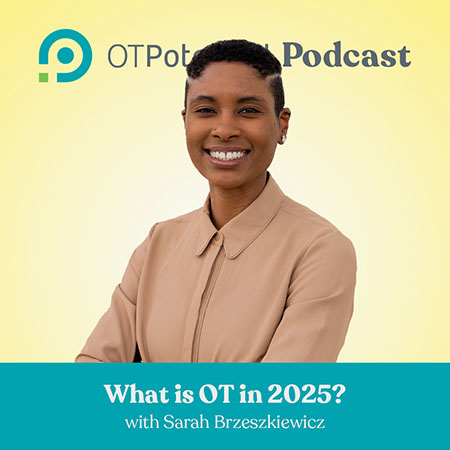
Occupational therapy (OT) helps people participate in their daily activities when they have a health condition or disability that may make participation difficult.
For school-based occupational therapists, this means helping a child participate in their schooling when there are barriers to doing so.
You may have found this article because your child was referred to school-based OT, or you may be an aspiring school OT yourself. Either way, we will do our best to answer your basic questions about school-based occupational therapy.
Here’s what we’ll cover:
- Your child’s right to an evaluation
- Mandates related to school-based OT
- OT’s role in schools
- What does an OT evaluation and an IEP entail?
- What does OT treatment entail?
- How do OTs support the entire student body?
- How does a school OT spend their time?
- Trends in school-based OT
- Our favorite resources about school-based OT
- Find a school-based OT near you
Your child’s right to evaluation if they have a disability
In the United States, school districts must provide a free appropriate public education (FAPE) to children with disabilities.
This means public schools must identify and evaluate students who may have disabilities at no cost to families. (This rule covers children from birth to 21.) As the parent or caregiver, you have the right to request an evaluation if you have concerns.
You can read about this federal policy, called IDEA, here. Child Find is a resource that walks you through the process of reaching out to your school to schedule an evaluation.
Other important mandates related school OT for your child
In addition to the right to evaluation mandated under IDEA, there are a couple more mandates we should review to ensure you fully understand school-based OT.
If your child does qualify for services, IDEA gives them the right to 3 basic things related to OT:
#1 An Individualized Education Plan
The individualized education plan (IEP) is a written document that lays out a plan for meeting a student’s unique educational needs. The IEP is developed by an IEP team (which may include an OT).
#2 Education in the Least Restrictive Environment
Education should take place in the Least Restrictive Environment (LRE) possible. This means children should not be pulled out of the general education classroom unnecessarily.
#3 Parent Participation
Parents or caregivers have the right to equal participation in this process. They are entitled to:
- Request an evaluation.
- Receive notification of a planned evaluation.
- Access planning and evaluation materials.
- Be involved in all meetings regarding their child’s placement and services.
It is important to note that children may receive OT services in school even if they don’t have an IEP. IDEA part B provides limited funds to cover early intervening services (EIS) for children “who have not yet been identified as needing special education or related services but who need additional academic and behavioral support to succeed in a general education environment.”
Occupational therapy’s role in schools
Now that we know the basic mandates that guide our practice, we can look at the specific role of OTs in helping individual students.
According to IDEA, occupational therapy includes:
- Improving, developing, or restoring functions impaired or lost through illness, injury, or deprivation;
- Improving the ability to perform tasks for independent functioning if functions are impaired or lost; and
- Preventing, through early intervention, initial or further impairment or loss of function.
That language sounds very general, so let’s look at the specifics of evaluation and treatment:
What does an OT evaluation and an IEP entail?
When a concern is raised, your occupational therapist will evaluate your child for any issue related to OT. For school-aged children and adolescents, OTs typically look at academics in addition to social participation, play and leisure, mental wellness, and self-care activities.
This blog post walks through the many steps of a school-based OT evaluation.
Here is a list of the standardized assessments a school OT may use (this gives you an idea of the specific areas OTs may look at related to your child’s ability to participate in school):
- Assessment of Life Habits
- Beery-Buktenica Developmental Test of Visual-Motor Integration
- Behavior Rating Inventory of Executive Function
- Bruininks-Oseretsky Test of Motor Proficiency
- Canadian Occupational Performance Measure
- Child Occupational Self Assessment
- Children’s Depression Inventory
- DeCoste Writing Protocol
- Developmental Assessment of Young Children
- Developmental Coordination Disorder – Questionnaire
- Developmental Test of Visual Perception
- Evaluation Tool of Children’s Handwriting
- Goal-Oriented Assessment of Lifeskills
- Little Developmental Coordination Disorder Questionnaire
- MacArthur-Bates Communicative Development Inventories
- McMaster Handwriting Assessment Protocol
- Miller Function and Participation Scales
- Mullen Scales of Early Learning
- Peabody Developmental Motor Scales
- Pediatric Specific Quality of Life Questionnaire
- Perceived Efficacy and Goal Setting System
- Preschool Language Scale
- Roll Evaluation of Activities of Life
- School Function Assessment
- Self Perception Profile for Children
- Sensory Processing Measure
- Sensory Profile™ 2
- The Short Child Occupational Profile
- Social Communication Questionnaire
- Social Responsiveness Scale
- Test of Gross Motor Development
- Test of Visual Perceptual Skill
- Wide Range Assessment of Visual Motor Abilities
After the evaluation, goals are crafted for the IEP—ideally in close collaboration with the student and parents. As with any pediatric OT intervention, treatment is most successful when guided by child-set goals. These goals are reviewed at least once a year, but can be reviewed more frequently if needed.
What does OT treatment entail?
OT treatment often focuses on the actual activity that is in the child’s goal area.
We call this a “top-down approach” (versus a “bottom-up approach,” which focuses on specific body structures and skills). We take this approach because it is supported by the most robust evidence.
Here are the steps associated with a top-down approach:
- Begin with the child’s goal.
- Practice real-life activities in natural environments.
- Use intense repetitions to activate neuroplasticity.
- Use scaffolding to find “just the right challenge.”
Here is a blog post summarizing the evidence behind some of the most common pediatric interventions. (Not all of these interventions can be done in a school setting, but the article will give you a sense of the scope of pediatric OT.)
In conjunction with the top-down approach, your OT will take into account evidence-based treatment best practices for your child’s specific condition. For example, here is an overview of OT for cerebral palsy.
Beyond individual treatment, school occupational therapists support students by making recommendations for environmental changes (like implementing adaptive seating or making classrooms sensory-friendly); providing adaptive tools; and educating teachers about the supports a child needs to succeed.
School-based OT at every level
As kids progress from preschool and kindergarten through middle and high school, their needs and goals change dramatically. Occupational therapists provide skilled services to help students succeed at every grade level. Some general areas of OT intervention across the education spectrum include:
- Preschool: OTs work in preschools to help children meet developmental milestones and gain school-readiness skills. Areas of intervention in this setting might include self-care skills like feeding and dressing, fine motor skills, social-emotional learning, sensory needs, and academic learning.
- Elementary school: In addition to the areas addressed by preschool OTs, elementary school OTs may focus on setting students up for academic success by working on processing and learning skills, modifying the classroom environment, or adapting classroom activities to the child’s skills.
- Middle school: OTs continue to support children in middle grades as they tackle more complex academic and life skills. Middle school OTs may target organizational skills, social and communication skills, sensory needs, or mental health and self-identity.
- High school: Teenagers and young adults up to 21 may also receive OT services in school. At this age, OT intervention is focused on the transition to post-graduation plans—whether that’s attending college, entering the workforce, living independently, or participating in the community.
At all grade levels, OTs work to perform screenings and evaluations, provide education and resources to teachers, and collaborate with other professionals to support whole-classroom wellness.
How do OTs support the entire student body?
While the majority of OTs work with students via individual, one-on-one sessions, OTs in the U.S. are also uniquely suited to provide services to the entire student body, including students in both general and special education classrooms.
The recently adopted Every Student Succeeds Act (ESSA) is an important piece of legislation when considering OT’s role at the population or group level. One of the primary purposes of ESSA is to encourage districts to support all students via early intervention and prevention approaches. ESSA names multi-tiered services, including Response to Intervention, as one way to accomplish this.
ESSA explicitly names OTs as Specialized Instructional Support Personnel (SISPs) and argues that SISPs are well-suited to providing multi-tiered services to all students.
Here’s a nice handout on OT’s role in supporting the student body through ESSA.
The PATH program is one example of an innovative curriculum that leverages social-emotional learning to create positive school environments for all learners. You can hear about how the PATH program has supported marginalized children with emotional disabilities in New York City Public Schools by checking out this OT Potential Podcast episode.
How does a school OT spend their time?
As you can tell, OT professionals wear many hats in the school-based setting.
When you are focused on meeting the needs of students, teachers, and other staff, your work week can get busy! Here is a list of weekly responsibilities for school-based OTs, as noted in this article:
- Scheduling students for treatments, consultations, etc.
- Completing daily documentation
- Directing student intervention or one-on-one sessions
- Providing staff consultation and education
- Providing family or caregiver consultation and education
- Conducting evaluations, re-evaluations, and screenings
- Writing reports (e.g., evaluations, screenings, etc.)
- Attending team meetings
- Conducting student observations
- Traveling between schools
- Engaging in professional development
- Developing treatment plans and materials
- Completing Medicaid paperwork
- Providing behavioral support (e.g., helping a student get on/off the bus each day)
- Attending committee and/or special education meetings
- Participating in events (e.g., back-to-school night)
- Consulting with outside providers
- Facilitating multi-tiered systems of support or Response to Intervention
- Participating in research and advocacy
- Participating in school committees
- Grant writing
Trends in school-based OT
We’d be remiss not to mention some important trends in school OT.
- Moving away from compliance-based interventions.
Compliance-based treatments involve rewarding children for certain behaviors while punishing others. This can produce short term results, but it can lead to long-term damage. Pediatric OTs are part of a larger movement toward recognizing the potential harm of this approach. New behavioral strategies—such as redirection—are becoming more common.
The book titled, “Connections Over Compliance” is a great resource for learning more about the benefits of this paradigm shift.
- Leveraging our training in mental health
OTs are unique among rehab professionals in that there is a focus on mental health in both our schooling and our scope of practice. And, there is a movement to utilize this dimension of our skill set to support the student body. See the website, Every Moment Counts, for a summary of occupational therapy-led mental health initiatives.
OT advocates are working hard to pass the Occupational Therapy Mental Health Parity Act, which would expand Medicaid coverage to allow OTs to provide more mental health and behavioral health services in schools and beyond.
3. Self-determination and strengths-based approaches
Rather than focusing solely on the deficits that impact a child’s schooling, occupational therapists leverage a strengths-based approach to consider the whole child—utilizing the child’s skills, interests, and inherent strengths to find the “just-right” challenge that will guide them toward successful learning.
The self-determination theory posits that meeting a student’s need for autonomy, competence, and relatedness can increase their internal motivation to be self-directed, lifelong learners. These approaches are supported by evidence and aim to increase positive self-identity, self-regulation skills, and motivation to engage in school.
Resources for school-based OTs
Phew! We’ve covered a lot of the essentials about school OT, but there is still more to learn! So, we will leave you with some resources for further exploration:
Statements by the AOTA on school-based OT:
- Expanding the role of school-based OT practitioners (AOTA, 2024)
- New Medicaid guidance for school-based services (AOTA, 2023)
- Supporting practitioners in the public schools and early intervention (AOTA, 2022)
- Workload Approach: A Paradigm Shift for Positive Impact on Student Outcomes (Joint Statement by AOTA, ASHA, and the APTA, 2014)
- Transforming caseload to workload in school-based occupational therapy services (AOTA, 2014)
- AOTA practice advisory on occupational therapy in response to intervention (AOTA, 2014)
Brochures and resources from the AOTA:
- What is the role of a school-based OT practitioner? (For School Administrators)
- What is the role of a school-based OT practitioner? (For Parents)
- School Mental Health Tool-kit
- Best Practices for Occupational Therapy in Schools
- School-Based Occupational Therapy: Myth vs Reality
The emerging research behind multi-tiered systems of support
- Multi-tiered systems of support for preschool-aged children: A review and meta-analysis
- Including College and Career Readiness Within a Multitiered Systems of Support Framework
- Multi-tiered Systems of Support for School-Based Mental Health: A Systematic Review of Depression Interventions
Websites by and for school-based OTs:
Recommended books for OTs and caregivers
- ADHD is Our Superpower
- Connections Over Compliance
- The “How to Talk” Series
- The Out-of-Sync Child (Sensory Processing)
- The Power of Showing Up
- Trauma-Responsive Pedagogy
- The Whole-Brain Child
- Uniquely Human (Autism)
A little bit about your school-based occupational therapist
As you can tell, a school-based OT brings a lot to the table. Here’s a little information about their career.
To become an OT in the US, you need a masters or doctoral degree. Beyond that, many OTs go on to earn specialized certifications and continuing education in their particular area of work. In general, OTs who work in schools make around $70,000 per year, while OTAs earn an average of $41,000 annually, according to the AOTA 2023 Compensation & Workforce Survey.
Find a school-based OT near you
If you are interested in taking a deeper dive into the world of school-based OT, it might help to connect with one. You can use the OT Directory to find a school-based OT in your area.
Conclusion
It is an honor for us as occupational therapists to serve students in a school-based setting. As OTs, it is our purpose and passion to meet our students exactly where they are—and we know our treatments are most effective when delivered in the places where people spend a lot of their time. So, it is meaningful for us to be working in a setting where kids spend so many of their waking hours.
We also know that helping children succeed can take a village. Working in schools gives us the awesome opportunity to partner with families, teachers, and other professionals who are invested in helping each and every child succeed.






